
An askari or ascari was a local soldier serving in the armies of the European colonial powers in Africa, particularly in the African Great Lakes, Northeast Africa and Central Africa. The word is used in this sense in English, as well as in German, Italian, Urdu, and Portuguese. In French, the word is used only in reference to native troops outside the French colonial empire. The designation is still in occasional use today to informally describe police, gendarmerie and security guards.

Ruanda-Urundi, later Rwanda-Burundi, was a colonial territory, once part of German East Africa, that was occupied by troops from the Belgian Congo during the East African campaign in World War I and was administered by Belgium under military occupation from 1916 to 1922. It was subsequently awarded to Belgium as a Class-B Mandate under the League of Nations in 1922 and became a Trust Territory of the United Nations in the aftermath of World War II and the dissolution of the League. In 1962 Ruanda-Urundi became the two independent states of Rwanda and Burundi.

Tabora is the capital of Tanzania's Tabora Region and is classified as a municipality by the Tanzanian government. It is also the administrative seat of Tabora Urban District. According to the 2012 census, the district had a population of 226,999.
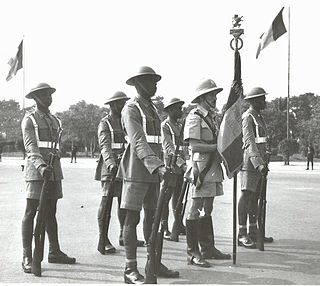
The Force Publique was a gendarmerie and military force in what is now the Democratic Republic of the Congo from 1877, through the period of Belgian colonial rule. The FP was retitled as the Congolese National Army or ANC in July 1960 after independence.
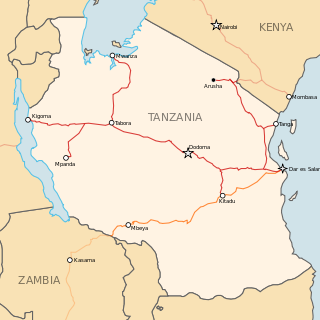
The Central Line, formerly known as the Tanganyika Railway is the most important railway line in Tanzania, apart from TAZARA. It runs west from Dar es Salaam to Kigoma on Lake Tanganyika via Dodoma. A branch leads to Mwanza on Lake Victoria.

The African theatre of the First World War comprises campaigns in North Africa instigated by the German and Ottoman empires, local rebellions against European colonial rule and Allied campaigns against the German colonies of Kamerun, Togoland, German South West Africa, and German East Africa. The campaigns were fought by German Schutztruppe, local resistance movements and forces of the British Empire, France, Italy, Belgium, and Portugal.

The East African campaign in World War I was a series of battles and guerrilla actions, which started in German East Africa (GEA) and spread to portions of Mozambique, Rhodesia, British East Africa, the Uganda, and the Belgian Congo. The campaign all but ended in German East Africa in November 1917 when the Germans entered Mozambique and continued the campaign living off Portuguese supplies.
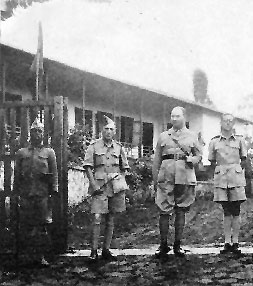
Auguste-Édouard Gilliaert was a Belgian colonial lieutenant general who served in both world wars, and a commander of the Force Publique in the Belgian Congo.

Lieutenant General Charles Tombeur, 1st Baron of Tabora was a Belgian military officer and colonial civil servant. As well as holding several major administrative positions in the Belgian Congo, he is particularly known for his role as commander of the Belgian colonial military, the Force Publique, during the first years of World War I. His military career culminated in the capture of Tabora in German East Africa in September 1916.

The involvement of the Belgian Congo in World War II began with the German invasion of Belgium in May 1940. Despite Belgium's surrender, the Congo remained in the conflict on the Allied side, administered by the Belgian government in exile.

The Battle of Tabora was a military action which occurred around the town of Tabora in the north-west of German East Africa during World War I. The engagement was part of the East Africa Campaign and was the culmination of the Tabora Offensive in which a Belgian force from the Belgian Congo crossed the border and captured the settlement of Kigoma and Tabora, pushing the German colonial army back. The victory not only left much of the Ruanda-Urundi territory under Belgian military occupation but gave the Allies control of the important Tanganjikabahn railway.
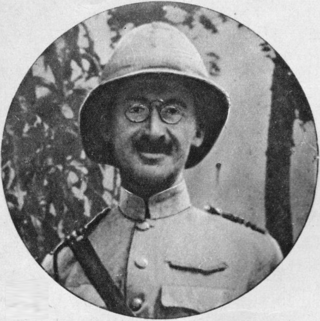
Armand Christophe Huyghé, later knighted Armand Huyghé de Mahenge, was a Belgian career soldier. He is best known for his service in the Belgian Congo during World War I, where he succeeded Charles Tombeur as commander of the Belgian forces in the East African Campaign in 1917. He commanded the Belgian contingent during the Allied occupation of the Rhineland after the war. During World War II, he was involved in the resistance and, after being captured by the Germans, was deported to Buchenwald concentration camp where he died in 1944.

The siege of Saïo or battle of Saïo took place during the East African Campaign of World War II. Belgo-Congolese troops, British Commonwealth forces and local resistance fighters besieged the fort at the market town of Saïo in south-western Ethiopia in 1941. The siege lasted for several months, culminating in an Allied attack on the Italian garrison thereby forcing it to surrender.

The Mahenge offensive was a military action which occurred around the Morogoro Region in the east of German East Africa during World War I. The combat formed part of the East Africa Campaign and ended with the capture of Mahenge by the Belgian forces on 9 October 1917.
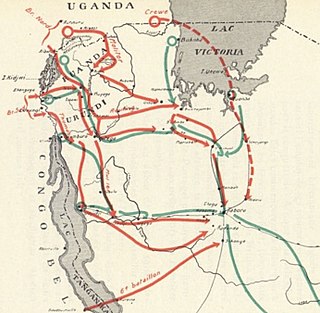
The Tabora Offensive was an Anglo-Belgian offensive into German East Africa, which ended with the Battle of Tabora in the north-west of German East Africa, it was part of the East African Campaign in World War I. The forces of the Belgian Congo crossed the border with German East Africa and captured the port city of Kigoma and the city of Tabora. In August a smaller Lake Force under the command of the South African brigadier general Crewe, launched a parallel attack from Uganda, also aimed at taking Tabora. The completion of the Tabora Offensive not only left much of the Ruanda-Urundi territory under Belgian military occupation but gave the Allies control of the important Tanganjikabahn railway.

Philippe Molitor was a Belgian military officer. He is known for his role as commander of the Brigade Nord of the Force Publique, during the Tabora Offensive in the East African Campaign.

Frederik-Valdemar Olsen was a Danish soldier who became a general and commander in chief of the Belgian Congo Force Publique. He was born into a poor family, joined the Danish army, then in 1898 volunteered to serve in the Congo Free State. He rose quickly through the ranks, and in 1909–1910 played an important role in a stand-off with German and British forces disputing the eastern border of what was now the Belgian Congo. During World War I Olsen commanded a force that defended Northern Rhodesia against a German attack, then advanced from the south of Lake Kivu to take Tabora in what is now Tanzania. After the war he became commander of the Force Publique before retiring as a general in 1925. Olsen was then made general manager of the state-owned Congo River shipping line Unatra, later combined with railway lines to form Otraco. He retired from this position in 1947.
John Methuen Coote was a British colonial administrator who served in the East Africa Protectorate. He is known for a stand-off with the Belgians over the location of the border between the Belgian Congo and the British territories.

The Kivu frontier incident was a 1909–1910 stand-off between Belgian, British and German forces in the region around Lake Kivu, now divided between the Democratic Republic of the Congo, Uganda and Rwanda. War was averted through diplomatic negotiations, and it was agreed that the western and northwestern part of the region came within the jurisdiction of the Belgian Congo, while the eastern part was divided between the British Uganda Protectorate to the northeast and the Rwanda district of German East Africa to the southeast.

Erich von Langenn-Steinkeller was a German military officer and official who served as the colonial resident of the Kingdom of Burundi in 1909 and from 1911 to 1916.



















